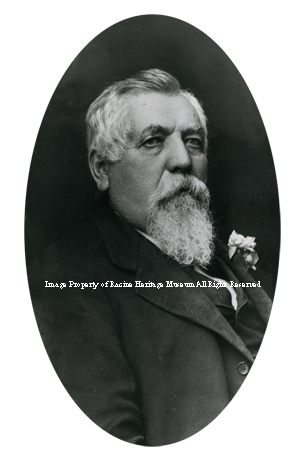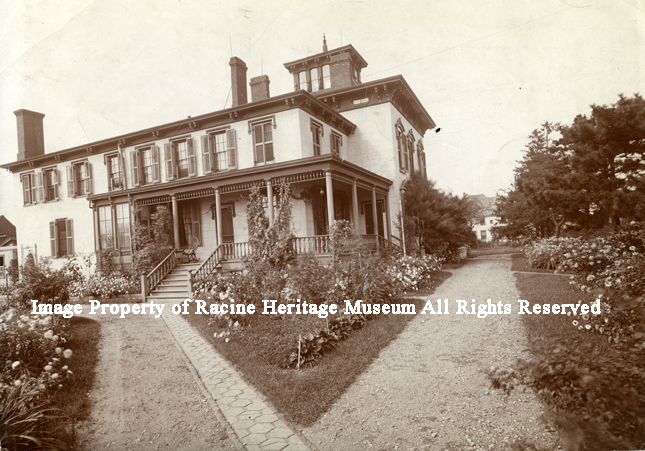SECOR: The Story of Racine’s Most Colorful & Controversial Character
Martin Mathias Secor—it’s a name that may not ring a bell to you, dear reader, but I assure you in all my research I have done, this man stands apart from the crowd. M.M. Secor was a Bohemian immigrant with a motto— “Anything worth doing at all is worth doing right.” [1] He was a character–an eccentric, some might say. With a tall stovepipe hat [2] adorning his already 6-foot stature, flowing white hair with a windswept mustache, [3] a flower from his garden always tucked in his lapel, [4] and a golden knobbed cane, [5] Secor was a man of distinction. He had a booming voice, people said–but a kind one nonetheless. [6] He was an entrepreneur who owned several businesses, including a nationally renowned luggage company, and he was a well-respected member of the Bohemian community. [7] Not only was he financially successful, but Secor also spread his wealth through various charitable avenues and to his own workers. [8] M.M. Secor was the man who could, and did, do it all.
A Bohemian Businessman
In 1851 Secor made his trip from Bohemia to the United States, and at the young age of eleven Secor had arrived in Racine County with his parents, Mathias and Fanny Secor, three sisters, and a brother. [9] His family soon settled into a log cabin on Four Mile Road. [10] He stayed on his father’s farm doing work until the age of fourteen when he left to start doing work of his own—odd jobs, mostly. [11] After living in Racine for some time, Secor found his future wife, Frances Hayes, also the child of Bohemian immigrants and on February 4, 1862 the two were married. [12]
Early Life

After building up a reputation for himself, in 1868 Secor decided it was time to plunge into the business world on his own. With $80 of his own money and $100 borrowed at 10% interest for ten years, he invested in his first company, the Northwestern Bag Company. [13] Originally, Secor made his trunks in his wife’s kitchen until he had the money for his own location. [14] The location he chose was on Main Street, but his company grew so rapidly that it soon required its own building to be constructed. Soon Secor’s trunk company stood on Lake Avenue, slowly growing until in 1888 the plant was composed of eight buildings [15] and around 125 employees. [16] It was recorded in 1918 that the building stretched all the way from 127 to 407 Lake Avenue. [17] Eventually Secor even incorporated several other companies and renamed his venture the Northwestern Trunk and Travelling Bag Company.[18] The buildings remained on Lake Avenue until their demolition in the summer of 1987.[19]

Secor had not only developed an impressive production of trunks that were popular with Racine residents, but they were known nationally. Secor’s trunks stood for quality, hearkening back to his favorite motto, “Anything worth doing at all is worth doing right.” It was said that one day on a trip to a department store in Denver, Secor purchased a trunk made by another manufacturer and dissected it with a jackknife in front of everyone to prove its “inferior quality.” [20] It is easy to just assume that the claims of the quality of his trunks were just legend but if you’re out around Racine in the summer stop by some thrift sales—some of his trunks that are well over 75-100 years old are still in decent shape being sold as antique luggage. [21]
Park of China Asters
With a successful business comes profit. M.M. Secor’s home, commonly known as the Park of China Asters, exemplified that wealth. [22] Secor moved from above his trunk salesroom on Main Street in 1874 to a beautiful mansion on Milwaukee Avenue (now known as Dr. Martin Luther King Drive) that took up the entire block. The building is thought to have originally been built for a lumber dealer in the early 1850s. [23] Secor lived there with his wife Fanny and his four daughters.

They had a lavish garden with Secor’s favorite red and white roses that he often cut to wear in his lapel, along with a rare species of black roses. He had a small orchard complete with a fig tree, a dwarf lemon tree, and many orange trees. There were two conservatories on the property and a five-basin goldfish pond, which was just one example of Secor’s exotic pets that lived on the ground. Secor had a proper menagerie on his estate. [24] Secor’s menagerie was home to a coyote—his first animal—two bears, a monkey, six deer, many parrots, rabbits, mockingbirds, a goat, and seven peacocks, five of which were killed by dogs that got onto his property in 1889. A deer was also injured in the attack. [25] Secor was incensed and threatened to shoot the “vicious canines” if they attacked his pets again. [26] After his death it was said that the Ringling Brothers Circus bought several of his animals. [27]
Progressive Philanthropist
Secor’s home was much larger than he needed for a family of six, even with the additional animals that lived on the property, so Secor decided to use his home as a boarding house for some of the men who worked for him at the trunk company. [28] In an 1880 census there were 28 people recorded as living in the Secor mansion—Secor and his own family, the family gardener and teamster, and eighteen boarders from his company. [29] On his 2 ½ acre property his gardens also provided much of the food his boarders ate and the excess was sold to others at a discounted price. Secor was an individualist and believed firmly in free enterprise, but also in humanity. [30] Secor was by all accounts, a very generous and progressive business owner. He believed that a man’s religion was how he lived and what he did, not what he believed in and Secor lived up to that very ideal. [31] Aside from providing room and board to his workers, Secor was well known for a work holiday of his own invention—Thirteenth Day. On Thirteenth Day, which occurred once a year, Secor would give every one of his employees an extra month’s salary. [32] He was proud and often reminded people that 95% of his workers owned their own homes. [33]
His benevolence was recognized around town and extended beyond his own company. Residents recalled how when he saw a poor or “shabby” child on the streets he would take them to the nearest shop and buy them coats, caps, and other clothing. [34] He also donated to charities, hospitals, and the local orphanage, the Taylor Home. [35] Because Secor did not believe that religion was in itself a charitable organization he made a point to never donate to churches. [36] Secor also donated to the city for construction projects that would benefit the public and was the mayor when Racine’s streets were first paved. [37] At one point in time, the Chicago Tribune published an article about Secor accusing him of being a drunk (due to his anti-prohibition views) [38] and of embezzling funds from a new bridge he built in Racine.
[39] He successfully sued the Chicago Tribune for libel and purchased a new illuminated four-sided clock that was installed in the tower of City Hall, [40] a building that he had at one point donated $7,000 toward the construction of. [41] Secor later said that the clock would ensure that there would be no excuse that people didn’t know when it was midnight—the time saloons closed in Racine. [42]
Secor was also the owner of the Nelson Hotel, [43] the First Bohemian National Bank of America, and a set of Turkish baths which were all located in the present-day Main Place (also known as the McClurg building). [44] He was also the first business owner in Racine to have his own business telephone, installed in 1881, and his daughters were the first stenographers in Racine due to the fact that Secor was also one of the first men to own typewriters in his office. [45]
Mayorship and the Assassination Attempt
Secor was not only a prolific businessman but also involved in politics. He ran on both the Republican and Democratic tickets for different positions and considered himself to be independent.[46] Secor ran twice for mayor, winning his first term as in 1884 and his second term in 1888.[47] Although he did many things for the city in his time as mayor, perhaps one of the most notable parts of his mayorship was when he was almost assassinated. To this day he is still Racine’s only mayor to have an assassination attempt on his life.
The attempt was made during his first term as mayor in 1884. He was riding home from a city council meeting when his carriage rode over a bomb that was placed in front of his home. The bomb did not immediately go off as the carriage rolled over it, so the bomber came out of hiding to inspect it—as he did so, it went off seriously injuring the man. [48] The suspect fled but spots of blood led back to the home of a former bookkeeper of Secor’s who had recently been dismissed. Although the bookkeeper was not the bomber, the suspect was, in fact, hiding in his home, a man by the name of John Jambor from Milwaukee. Some believe that the bookkeeper was in on the plot, but it was never proven. [49] Secor was apparently so rattled by the near-death experience that from then on he was always seen holding the reigns from the backseat of his carriage, where he felt safer. [50]
A Lasting Legacy

Secor passed away in his home after a deadly fall in 1911 at 69 years old. The news article that reported his death said he fell a week prior on a Tuesday when he was getting up from his bed. Secor fell upon one of his bedposts, breaking three ribs, one of which punctured his lungs. He contracted a serious cold afterward and died due to complications. The flags at City Hall and his trunk company were lowered in honor of the former mayor. [51] His company continued for a full seven years after his death, [52] being one of the largest in the United States at the time. [53]
Before his death, Secor had his headstone erected in Mound Cemetery. It caused quite a bit of controversy. Engraved in the headstone was a somewhat contentious quote by Voltaire, a favorite philosopher of his.
THIS WORLD IS MY HOME
TO DO GOOD IS MY RELIGION
WHY DID THE GOOD GOD CREATE A BAD DEVIL? [54]
So many people were outraged by the message on the tombstone that is was debated on whether or not it would even be placed in the cemetery. However, it was. Attempts continued to be made to have the headstone removed from the cemetery as late as the 1930s. [55]
Secor’s progressive attitude and sense of philanthropy have left a lasting impact on the Racine community. He may have been mostly forgotten but this character can never be dashed from the historical record. Secor’s life and legacy are a fascinating look into Racine’s manufacturing history and politics of the late 1800s.
Sources
[1] “Freethought Trunks and Travelling Bags.” Freethought Today (Madison, WI) June/July 1990.
[2] “Tombstone Epitaph Recalls Controversial Racine Mayor,” Racine Journal Times (Racine, WI) August 19, 1973.
[3] “Forty-Two Men Held Mayor’s Post During Racine’s 105 Years as a City,” Racine Journal Times (Racine, WI) February 6, 1953.
[4] Racine Journal Times (Racine, WI) August 18, 1998.
[5] “Tombstone Epitaph Recalls Controversial Racine Mayor,” Racine Journal Times
[6] “Forty-Two Men Held Mayor’s Post During Racine’s 105 Years as a City,” Racine Journal Times
[7] “Freethought Trunks and Travelling Bags.” Freethought Today
[8] “Tombstone Epitaph Recalls Controversial Racine Mayor,” Racine Journal Times
[9] Soldiers and Citizens’ Album of Biographical Record (Chicago: Grand Army Publishing Co, 1890)
[10] Ibid.
[11] Soldiers and Citizens’ Album of Biographical Record (Chicago: Grand Army Publishing Co, 1890)
[12] Ibid.
[13] “A Secor Biography,” Preservation Racine Newsletter (Racine, WI) Spring 1990.
[14] “Business started in his kitchen,” Racine Journal Times (Racine, WI) April 26, 1986.
[15] Ibid.
[16] “Tombstone Epitaph Recalls Controversial Racine Mayor,” Racine Journal Times
[17] “A Secor Biography,” Preservation Racine Newsletter
[18] Soldiers and Citizens’ Album of Biographical Record (Chicago: Grand Army Publishing Co, 1890)
[19] “So what’s new about Hill hotel proposal?” Racine Journal Times (Racine, WI) August 1, 1987.
[20] File 1, Folder 1. Secor, M.M. Vertical File. (Racine Heritage Museum, Racine, WI)
[21] Ibid.
[22] “A Secor Biography,” Preservation Racine Newsletter
[23] File 1, Folder 1. Secor, M.M. Vertical File. (Racine Heritage Museum, Racine, WI)
[24] Ibid.
[25] “Why not Secor Park?” Racine Journal Times (Racine, WI) January 15, 1983.
[26] Racine Journal Times (Racine, WI) August 18, 1998.
[27] Margo Drummond, The Legend of M.M. Secor (Racine) 26.
[28] File 1, Folder 1. Secor, M.M. Vertical File. (Racine Heritage Museum, Racine, WI)
[29] Ibid.
[30] Ibid.
[31] Ibid.
[32] “Tombstone Epitaph Recalls Controversial Racine Mayor,” Racine Journal Times
[33] Ibid.
[34] Ibid.
[35] Ibid.
[36] File 1, Folder 1. Secor, M.M. Vertical File. (Racine Heritage Museum, Racine, WI)
[37] “Tombstone Epitaph Recalls Controversial Racine Mayor,” Racine Journal Times
[38] Racine Journal Times (Racine, WI) August 18, 1998.
[39] Margo Drummond, The Legend of M.M. Secor (Racine) 17-18.
[40] “Why not Secor Park?” Racine Journal Times
[41] Racine Journal Times (Racine, WI) August 18, 1998.
[42] “Why not Secor Park?” Racine Journal Times
[43] “So what’s new about Hill hotel proposal?” Racine Journal Times
[44] Margo Drummond, The Legend of M.M. Secor (Racine) 5.
[45] “Tombstone Epitaph Recalls Controversial Racine Mayor,” Racine Journal Times
[46] Soldiers and Citizens’ Album of Biographical Record (Chicago: Grand Army Publishing Co, 1890)
[47] “Long, short terms,” Racine Journal Times (Racine, WI) April 29, 1984.
[48] “Tombstone Epitaph Recalls Controversial Racine Mayor,” Racine Journal Times
[49] “Freethought Trunks and Travelling Bags.” Freethought Today
[50] “Tombstone Epitaph Recalls Controversial Racine Mayor,” Racine Journal Times
[51] “Ex-Mayor Secor Has Passed Away,” Racine Daily Journal (Racine, WI) January 5, 1911.
[52] Margo Drummond, The Legend of M.M. Secor (Racine) 26.
[53] “Tombstone Epitaph Recalls Controversial Racine Mayor,” Racine Journal Times
[54] Ibid.
[55] “Freethought Trunks and Travelling Bags.” Freethought Today
